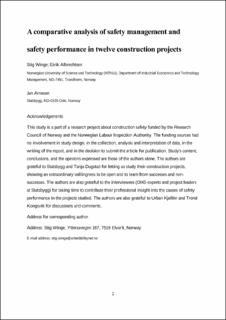| dc.description.abstract | Safety management in construction is complicated due to the complex “nature” of the construction industry. The aim of this research was to identify safety management factors (e.g., risk management and site management), contextual factors (e.g., organisational complexity) and combinations of such factors connected to safety performance. Method: Twelve construction projects were selected to compare their safety management and safety performance. An analytical framework was developed based on previous research, regulations, and standards where each management factor was defined. We employed qualitative comparative analysis (QCA) to produce case knowledge, compare the cases, and identify connections between the factors and safety performance. The material collected and analyzed included, for example, construction planning documents, reports from OHS-inspections, safety indicators, and interviews with project leaders and OHS experts. Results and conclusions: The research showed that: (a) the average score on 12 safety management factors was higher among projects with high safety performance compared to projects with low safety performance; (b) high safety performance can be achieved with both high and low construction complexity and organizational complexity, but these factors complicate coordination of actors and operations; (c) it is possible to achieve high safety performance despite relatively poor performance on many safety management factors; (d) eight safety management factors were found to be “necessary” for high safety performance, namely roles and responsibilities, project management, OHS management and integration, safety climate, learning, site management, staff management, and operative risk management. Site management, operative risk management, and staff management were the three factors most strongly connected to safety performance. Practical implications: Construction stakeholders should understand that the ability to achieve high safety performance in construction projects is connected to key safety management factors, contextual factors, and combinations of such factors. | en_US |

